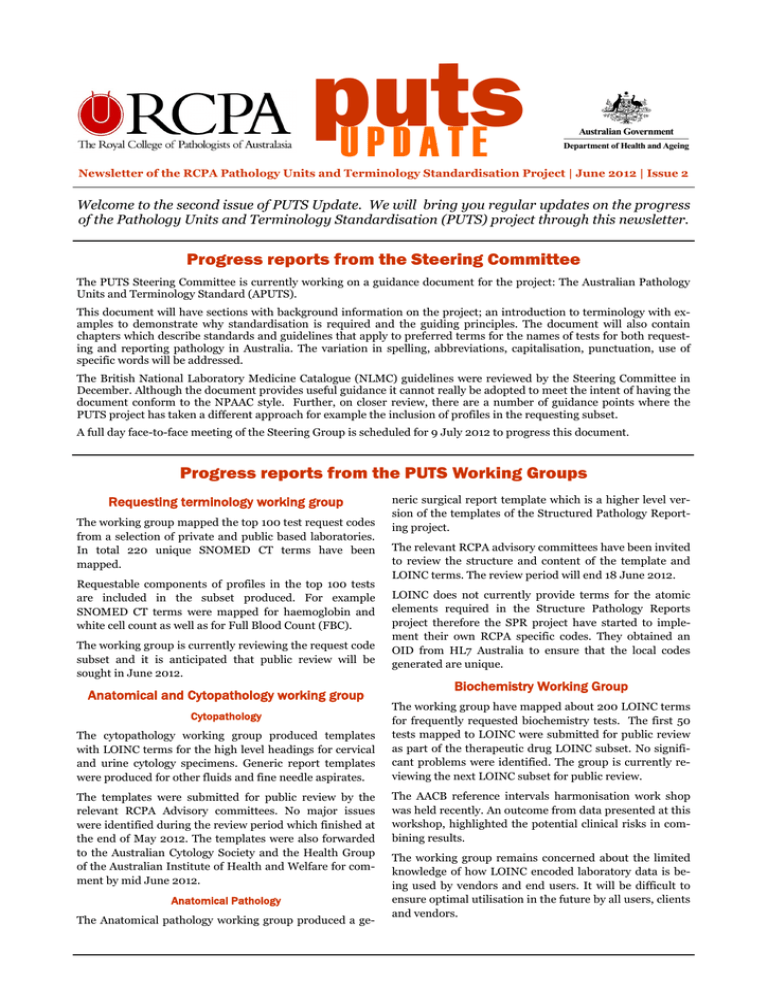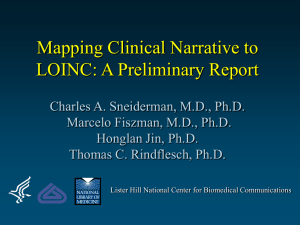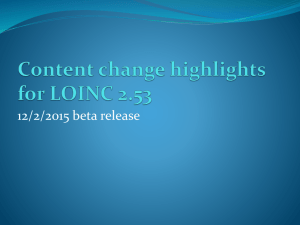p uts U P D A T E
advertisement

pU Puts DATE Newsletter of the RCPA Pathology Units and Terminology Standardisation Project | June 2012 | Issue 2 Welcome to the second issue of PUTS Update. We will bring you regular updates on the progress of the Pathology Units and Terminology Standardisation (PUTS) project through this newsletter. Progress reports from the Steering Committee The PUTS Steering Committee is currently working on a guidance document for the project: The Australian Pathology Units and Terminology Standard (APUTS). This document will have sections with background information on the project; an introduction to terminology with examples to demonstrate why standardisation is required and the guiding principles. The document will also contain chapters which describe standards and guidelines that apply to preferred terms for the names of tests for both requesting and reporting pathology in Australia. The variation in spelling, abbreviations, capitalisation, punctuation, use of specific words will be addressed. The British National Laboratory Medicine Catalogue (NLMC) guidelines were reviewed by the Steering Committee in December. Although the document provides useful guidance it cannot really be adopted to meet the intent of having the document conform to the NPAAC style. Further, on closer review, there are a number of guidance points where the PUTS project has taken a different approach for example the inclusion of profiles in the requesting subset. A full day face-to-face meeting of the Steering Group is scheduled for 9 July 2012 to progress this document. Progress reports from the PUTS Working Groups Requesting terminology working group The working group mapped the top 100 test request codes from a selection of private and public based laboratories. In total 220 unique SNOMED CT terms have been mapped. Requestable components of profiles in the top 100 tests are included in the subset produced. For example SNOMED CT terms were mapped for haemoglobin and white cell count as well as for Full Blood Count (FBC). The working group is currently reviewing the request code subset and it is anticipated that public review will be sought in June 2012. Anatomical and Cytopathology working group Cytopathology The cytopathology working group produced templates with LOINC terms for the high level headings for cervical and urine cytology specimens. Generic report templates were produced for other fluids and fine needle aspirates. The templates were submitted for public review by the relevant RCPA Advisory committees. No major issues were identified during the review period which finished at the end of May 2012. The templates were also forwarded to the Australian Cytology Society and the Health Group of the Australian Institute of Health and Welfare for comment by mid June 2012. Anatomical Pathology The Anatomical pathology working group produced a ge- neric surgical report template which is a higher level version of the templates of the Structured Pathology Reporting project. The relevant RCPA advisory committees have been invited to review the structure and content of the template and LOINC terms. The review period will end 18 June 2012. LOINC does not currently provide terms for the atomic elements required in the Structure Pathology Reports project therefore the SPR project have started to implement their own RCPA specific codes. They obtained an OID from HL7 Australia to ensure that the local codes generated are unique. Biochemistry Working Group The working group have mapped about 200 LOINC terms for frequently requested biochemistry tests. The first 50 tests mapped to LOINC were submitted for public review as part of the therapeutic drug LOINC subset. No significant problems were identified. The group is currently reviewing the next LOINC subset for public review. The AACB reference intervals harmonisation work shop was held recently. An outcome from data presented at this workshop, highlighted the potential clinical risks in combining results. The working group remains concerned about the limited knowledge of how LOINC encoded laboratory data is being used by vendors and end users. It will be difficult to ensure optimal utilisation in the future by all users, clients and vendors. 2 The group decided to implement a traffic light system to classify results into groups. Those allocated to the red group should never be combined. Only tests known to be well harmonized or where there is no clinical risk will be placed in the green category. Orange is reserved for those where caution is required in any combination of results and indicates that the risk of doing this should be assessed on the receiving end of the result. The next project for the Haematology working group will be to produce a template for the high level headings in the Bone Marrow report. The group presented the following principles to the Steering committee: The auto-antibody LOINC subset review period is now over and no issues were identified. The remaining subsets will be forwarded for review in June 2012. There is clinical risk in combining data. The signed-off fully formatted PDF version of a laboratory report with comments and cautions should always be available for reference in the receiving system and the reviewing clinician is encouraged to reference this in making any clinical decision. The working group believes that the least variation and safest approach for monitoring a chronic disease is to use the same laboratory. The pre-coordinated elements derived from a LOINC coded result does not contain all of the information needed to confidently group data from different laboratories for statistical purposes. If laboratory data is required for research the source laboratory should be contacted. Immunopathology working group The working group produced LOINC subsets for the autoantibodies, immunochemistry (including protein electrophoresis) and flow cytometry of t-cell subsets. The group decided to indefinitely postpone the mapping of flow cytometry of haematological malignancies due lack of standardisation of the tests required for the diagnosis. Microbiology working group In addition to the SNOMED organisms list, the microbiology working group have mapped around 300 LOINC terms for tests of the QAP Serology programs. This was done recently in two productive face-to-face workshops. The group is currently reviewing the subset in preparation for public review. The next task of the working group will be to develop a report template with LOINC mapping for the urine microscopy, culture and sensitivity report. Genetic Pathology working group Units working group The working group produced a logical framework of a generic genetic report with LOINC terms bound to some of the elements. It was decided that LOINC currently does not fulfil the requirements for Genetic Pathology and further discussions with Regenstrief will be required. With the assistance of the QAP a survey was sent to laboratories taking part in the RCPA QAP Tumour marker program. This survey attempted to determine if there is a difference in the way laboratories report units in patient reports to clinicians compared to reporting to the QAP. The generic genetic report framework was submitted for public consultation and a few productive comments were received. The working group will now implement the suggestions and consider broader consultation to what the generic report should look like. More than 50% of Australian laboratories enrolled in the program responded and provided useful information. A similar survey with laboratories enrolled in the QAP Endocrine program is underway. The next survey, starting early July 2012 will assess the units used in the reporting of Haemostasis assays. Haematology working group The working group recently submitted a subset with 107 LOINC mapped tests for public review by the RCPA advisory committee as well as the Australasian Society of Thrombosis & Haemostasis and the Haematology Society of Australia and New Zealand. This subset includes the routine high volume haematology tests as well as more specialised tests such as the haemostasis and coagulation assays. The working group is currently corresponding with relevant oncology and obstetric associations to determine the preferred unit for Alpha fetoprotein, one of the problematic assays identified in the Tumour marker survey. Graham Jones produced a draft document with the principles for Units selection aimed at providing a framework for assisting with difficult choices in the standardisation of units. These principles will be included in the APUT Standard. Please note: In all cases public comment will be sought on the output from the working groups in the PUTS project. Public promotion of the project A paper was presented at the Pathology Update on the Project by the Biochemistry Working Group Chair Robert Flatman. Two other papers have been written relating to the project for Biochemistry Reviews and are currently ‘in press’. A paper has been written by the Chair of the Units Working Group Graham Jones on units for drugs in Australia and that is undergoing review for another journal. Michael Legg is presenting, by invitation, work from the Genetics Working Group at an International Meeting on ‘Practical, Preventive, Predictive and Personalised Medicine’ in St Petersburg in June.


